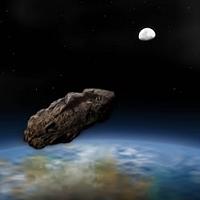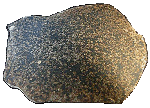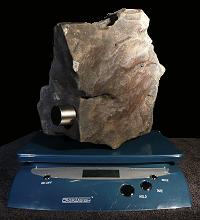Meteorites 101
 ©2007 asliceofspace.com |
 Most meteorites originated in the asteroid belt, which orbits the sun between Mars and Jupiter and contains enough material to assemble a minor planet about 1/20 the size of our moon if it were possible to aggregate it. Asteroids have produced stony meteorites (chondrites and achondrites), iron meteorites and stony-iron meteorites, all of which mostly likely were dislodged from previously stable orbits and sent on a collision course with Earth by a significant impact event or a gravitational perturbation from a larger object such as Jupiter.
Most meteorites originated in the asteroid belt, which orbits the sun between Mars and Jupiter and contains enough material to assemble a minor planet about 1/20 the size of our moon if it were possible to aggregate it. Asteroids have produced stony meteorites (chondrites and achondrites), iron meteorites and stony-iron meteorites, all of which mostly likely were dislodged from previously stable orbits and sent on a collision course with Earth by a significant impact event or a gravitational perturbation from a larger object such as Jupiter.
Meteorites are also known to have originated on both the moon and Mars. We have visited both worlds (the former via NASA's Apollo program in the late 1960's and early 1970's,  and the latter via a series of unmanned missions centered around a variety of sophisticated rovers), and, having studied ratios of stable isotopes such as oxygen-16, oxygen-17 and oxygen-18, have come to understand the signature of these parent bodies to the extent whereby we can all but absolutely connect the origin of certain meteorites to these bodies.
and the latter via a series of unmanned missions centered around a variety of sophisticated rovers), and, having studied ratios of stable isotopes such as oxygen-16, oxygen-17 and oxygen-18, have come to understand the signature of these parent bodies to the extent whereby we can all but absolutely connect the origin of certain meteorites to these bodies.
Lastly - and this remains theoretical for the moment - we have good reason to believe that meteorites have arrived on our planet's surface which originated in comet bodies (some carbonaceous chondrites) and perhaps Mercury (certain angrites). It is also possible that historic impact events have ejected material from the surface of Earth into orbit for some period of time which subsequently reentered our atmosphere and survived to return to our surface as a meteorite.
We know of their ancient ages because we are able to measure ratios of unstable radioactive isotopes (such as uranium) and their stable daughter isotopes (such as lead, in the case of uranium) as they have decayed with predictable half lives. This is similar in concept to measuring the amount of sand in the upper and lower bulbs of an hourglass after a given passage of time.
Undifferentiated meteorites:
Undifferentiated meteorites, known as chondrites, represent approximately 86% of all witnessed meteorite falls. Though several sub classes now exist, the most common are ordinary chondrites and carbonaceous chondrites.
- Ordinary chondritesOrdinary chondrites represent about 82% of all witnessed falls and originated in the inner and central portions of the asteroid belt. None of them have undergone gravitational differentiation (explained below), and it is this class of meteorites which are older than Earth itself. Chondrites are named after the spherical inclusions found in their matrices, known as chondrules; these are the first solid bodies that formed in our protoplanetary disk (the cloud of gas and dust which eventually became our solar system).
- Carbonaceous chondritesSome carbonaceous chondrites, which formed at the outer reaches of the asteroid belt - and perhaps in the Kuiper Belt and Oort Cloud (the region well beyond the orbit of Pluto where comets originated) - contain complex organic compounds including a variety of amino acids which have never been identified on our planet, a high percentage water and carbon (thus the name), pre-solar diamonds and calcium-aliminum rich inclusions (the latter two of which are older than our solar system itself).


Differentiated meteorites:
This category represents the other 14% of witnessed falls. These meteorites come from parent bodies in the asteroid belt which contained enough unstable radioactive isotopes to generate the required amount of heat through decay of the same to become molten, were party to massive impact events which released enough energy to create a temporarily molten parent body or, perhaps, were large enough to become molten by virtue of the pressures inherent in their own gravitational forces. Regardless of the initial cause(s), once these parent bodies became molten they started a very long process of cooling from temperatures of as much as several thousand degrees and recrystallizing into solid bodies once again. Heavier elements such as nickel, iron and iridium migrated to the core of these parent bodies during the molten state, and lighter elements present in silicates (in many cases quite similar to "Earth rocks") were pushed to the mantle and crust.
- IronsThe first of three differentiated meteorite classes, represent about 5% of all witnessed meteorite falls. They are the result of solid crystals growing while heavy molecules stacked themselves into order while the parent bodies cooled at the very slow rate of about one degree Fahrenheit every million years or so. Octahedrites (eight-sided crystals) and hexahedrites (six-sided crystals) are examples of such irons, and their crystal patterns can be seen on the face of cut, polished and acid-etched specimens. They are highly dense materials and represent the image that most novices first think of when hearing the term "meteorite."
- AchondritesThe next class of differentiated meteorites, contain little-to-no ferrous metals and are in many ways similar to Earth rocks. They represent about 8% of all witnessed falls, and because of their similarity to terrestrial rocks are extremely difficult to find if not witnessed during atmospheric entry. In the case of achondrites which come from very large parent bodies, such as the moon or Mars, their ages can often be substantially younger than most other meteorites (for example, some were formed just over 1 billion years ago in basaltic lava flows on the surface of Mars).
- Stony-ironsThese represent about 1% of witnessed falls and are the final class of differentiated meteorites. The most common variety of stony-iron, pallasites, likely originated at the core/mantel boundary on a large parent body. These specimens feature pure olivine (also known as the semi-precious gem, Peridot, here on Earth) inclusions throughout a nickel-iron matrix and, when sliced thinly enough to allow the passage of light through them are maybe the most beautiful of all meteorite specimens known.




There are several initial indicators which can help in identifying a meteorite
- Is it "heavier than it looks?"
- Does it have "thumb prints" (regmaglypts) on its surface?
- Does it show signs of rust?
- If metal, does it pass a nickel test?
- Is it "angular" (i.e having defined faces but with at least slightly rounded corners)?
- Is a magnet attracted to it?
- Buying Meteorites:There are many dealers trading in meteorite specimens on eBay and through a number of dedicated web sites. Without experience, it is easy to get burned by a poor buying decision by acquiring material which is unstable or simply not what it is advertised to be. Proper research and education are quite important for the budding collector.
- Insurance:Meteorite specimens are difficult if not impossible to insure for a variety of reasons, so proper precautions should be taken for their security.
- Preservation:Terrestrial conditions - particularly humidity and oxygen - are not friendly to many varieties of meteorites, so local conditions should be taken into consideration before acquiring certain meteorite specimens and classifications.
- Learning More:Most science teachers in the United States know very little about meteoritics (the study of meteorites), and this is in part because the curriculum in most school systems does little to cover this relatively young science. Great opportunities exist to expose students to these wonderful objects in your local area, and because there is little knowledge on the street at this point all you have to do is show up and simply say "I don't know" if you get a question you can't answer.
- Documentation:Keep all materials (certificates of authenticity, emails, photographs, historic labels, etc) related to the acquisition of a new collection piece, as provenance is a critical factor in the long term value of a meteorite specimen.
- Legal Issues:Depending on the location of a meteorite find, certain local, regional or national laws might be established to determine the rightful owner of a recovered meteorite specimen. Countries such as Canada, Australia and Argentina prohibit the export of meteorites, as they are deemed within those borders as national treasures.